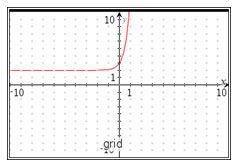As you will recall from your study of parent functions, adding a constant to a function shifts the function vertically. In this section, you will explore the effects of adding a constant to logarithmic and exponential functions.
![]() Below are four functions, four graphs, and four descriptions of translations to the graphs of some exponential and logarithmic functions. Some functions, graphs, and descriptions have already been placed in the table. Place the remaining functions, graphs, and descriptions in the correct place.
Below are four functions, four graphs, and four descriptions of translations to the graphs of some exponential and logarithmic functions. Some functions, graphs, and descriptions have already been placed in the table. Place the remaining functions, graphs, and descriptions in the correct place.
Interactive popup. Assistance may be required.
The sign of the constant term tells you the direction of the vertical translation. If the sign is positive, then the vertical translation is upward. If the sign is negative, then the vertical translation is downward.
Interactive popup. Assistance may be required.
The magnitude of the constant term tells you the distance of the vertical translation. For example, if the constant term is +7, then the vertical translation is 7 units upward. If the constant term is −3, then the vertical translation is 3 units downward.
How does the vertical translation of exponential and logarithmic functions compare to the vertical translation of other functions, such as quadratic, square root, or rational functions?
Interactive popup. Assistance may be required.
The vertical translation of all functions works the same, regardless of the function family. The sign of the constant term tells you the direction of the vertical translation (upward or downward), and the number in the constant term tells you the distance of the translation.
 The vertical shift is 3 units down from the parent function.
The vertical shift is 3 units down from the parent function.

 A constant of 6 has been added to the parent function.
A constant of 6 has been added to the parent function.


 A constant of 2 has been added.
A constant of 2 has been added.
